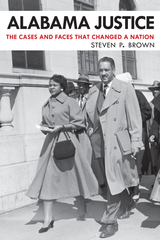5 books about Michigan's Upper Peninsula
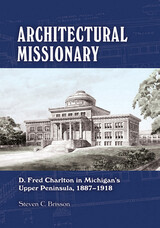
Architectural Missionary
D. Fred Charlton in Michigan's Upper Peninsula, 1887–1918
Steven C. Brisson
Michigan State University Press, 2021
The first and most prolific professional architect to reside permanently in Michigan’s Upper Peninsula, D. Fred Charlton used the local Lake Superior sandstone to craft the distinctive style found in buildings throughout Michigan’s Upper Peninsula. Born in England and trained there as a civil engineer, Charlton came to Detroit in the late 1870s, seeking work as a draftsman. Much like his peers of the time, he had no formal training as an architect and learned his trade by working at several prominent firms. The last, Scott & Company, sent him to Marquette in 1887 to open a branch office. Three years later, Charlton opened his own firm, and over the next twenty-eight years, he designed more than four hundred buildings, including residences, commercial structures, schools, courthouses, and churches throughout the region, which offer an invaluable insight into the tastes of Americans before the World War I and provide a unique vantage point for studying the evolution of the architectural profession. Deftly adapting national trends, he provided the communities of the Upper Peninsula with modern structures worthy of any place in the nation. Many of his buildings remain to this day, monuments to the skill of this English-born architect who made a place for himself upon the shores of Lake Superior. Anyone interested in architecture and in the history of the upper Midwest will find this read both fascinating and informative.
[more]
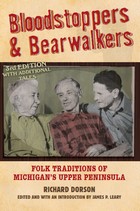
Bloodstoppers and Bearwalkers
Folk Traditions of Michigan’s Upper Peninsula
Richard M. Dorson
University of Wisconsin Press, 2008
Remote and rugged, Michigan’s Upper Peninsula (fondly known as “the U.P.”) has been home to a rich variety of indigenous peoples and Old World immigrants—a heritage deeply embedded in today’s “Yooper” culture. Ojibwes, French Canadians, Finns, Cornish, Poles, Italians, Slovenians, and others have all lived here, attracted to the area by its timber, mineral ore, and fishing grounds. Mixing local happenings with supernatural tales and creatively adapting traditional stories to suit changing audiences, the diverse inhabitants of the U.P. have created a wealth of lore populated with tricksters, outlaws, cunning trappers and poachers, eccentric bosses of the mines and lumber camps, “bloodstoppers” gifted with the lifesaving power to stop the flow of blood, “bearwalkers” able to assume the shape of bears, and more.
For folklorist Richard M. Dorson, who ventured into the region in the late 1940s, the U.P. was a living laboratory, a storyteller’s paradise. Bloodstoppers and Bearwalkers, based on his extensive fieldwork in the area, is his richest and most enduring work. This new edition, with a critical introduction and an appendix of additional tales selected by James P. Leary, restores and expands Dorson’s classic contribution to American folklore. Engaging and well informed, the book presents and ponders the folk narratives of the region’s loggers, miners, lake sailors, trappers, and townsfolk. Unfolding the variously peculiar and raucous tales of the U.P., Bloodstoppers and Bearwalkers reveals a vital component of Upper Midwest culture and a fascinating cross-section of American society.
[more]
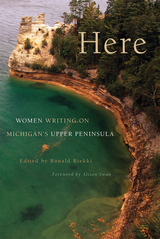
Here
Women Writing on Michigan's Upper Peninsula
Ronald Riekki
Michigan State University Press, 2015
How does place impact prose? Here: Women Writing on Michigan’s Upper Peninsula explores that very question, drawing on the work of Upper Peninsula authors past and present to create a vibrant kaleidoscope of voices and experiences. Bame-wa-wa-ge-zhik-aquay, Janet Loxley Lewis, Lorine Niedecker, Catie Rosemurgy, and thirty-one other authors important to the region appear in this exceptional and diverse volume. In poetry (“Spring” by Beverly Matherne, “For Those Who Dream of Cranes” by Elinor Benedict, and “Skin on Skin” by Sally Brunk), short fiction (“North Country” by Roxane Gay, “For the Healing of All Women” by April Lindala, and “Winter Mines” by Sharon Dilworth), and novel excerpts (from Once on This Island by Gloria Whelan, South of Superior by Ellen Airgood, and Dandelion Cottage by Carroll Watson Rankin), the unique character of the U.P. materializes on the page. The book also shines a spotlight on powerful emerging voices such as Lisa Fay Coutley, Charmi Keranen, and Saara Myrene Raappana. The first of its kind, this is an anthology for all seasons, an homage to the rich literary heritage of the region.
[more]
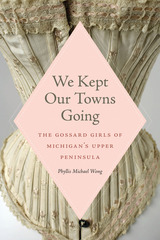
We Kept Our Towns Going
The Gossard Girls of Michigan's Upper Peninsula
Phyllis Michael Wong
Michigan State University Press, 2022
WITH A FOREWORD BY LISA M. FINE, MICHIGAN STATE UNIVERSITY—Michigan’s Upper Peninsula is known for its natural beauty and severe winters, as well as the mines and forests where men labored to feed industrial factories elsewhere in the nineteenth and twentieth centuries. But there were factories in the Upper Peninsula, too, and women who worked in them. Phyllis Michael Wong tells the stories of the Gossard Girls, women who sewed corsets and bras at factories in Ishpeming and Gwinn from the early twentieth century to the 1970s. As the Upper Peninsula’s mines became increasingly exhausted and its stands of timber further depleted, the Gossard Girls’ income sustained both their families and the local economy. During this time the workers showed their political and economic strength, including a successful four-month strike in the 1940s that capped an eight-year struggle to unionize. Drawing on dozens of interviews with the surviving workers and their families, this book highlights the daily challenges and joys of these mostly first- and second-generation immigrant women. It also illuminates the way the Gossard Girls navigated shifting ideas of what single and married women could and should do as workers and citizens. From cutting cloth and distributing materials to getting paid and having fun, Wong gives us a rare ground-level view of piecework in a clothing factory from the women on the sewing room floor.
[more]
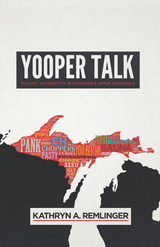
Yooper Talk
Dialect as Identity in Michigan's Upper Peninsula
Kathryn A. Remlinger
University of Wisconsin Press, 2019
Yooper Talk is a fresh and significant contribution to understanding regional language and culture in North America. The Upper Peninsula of Michigan—known as "the UP"—is historically, geographically, and culturally distinct. Struggles over land, labor, and language during the last 150 years have shaped the variety of English spoken by resident Yoopers, as well as how they are viewed by outsiders.
Drawing on sixteen years of fieldwork, including interviews with seventy-five lifelong residents of the UP, Kathryn Remlinger examines how the idea of a unique Yooper dialect emerged. Considering UP English in relation to other regional dialects and their speakers, she looks at local identity, literacy practices, media representations, language attitudes, notions of authenticity, economic factors, tourism, and contact with immigrant and Native American languages. The book also explores how a dialect becomes a recognizable and valuable commodity: Yooper talk (or "Yoopanese") is emblazoned on t-shirts, flags, postcards, coffee mugs, and bumper stickers.
Yooper Talk explains linguistic concepts with entertaining examples for general readers and also contributes to interdisciplinary discussions of dialect and identity in sociolinguistics, anthropology, dialectology, and folklore.
Drawing on sixteen years of fieldwork, including interviews with seventy-five lifelong residents of the UP, Kathryn Remlinger examines how the idea of a unique Yooper dialect emerged. Considering UP English in relation to other regional dialects and their speakers, she looks at local identity, literacy practices, media representations, language attitudes, notions of authenticity, economic factors, tourism, and contact with immigrant and Native American languages. The book also explores how a dialect becomes a recognizable and valuable commodity: Yooper talk (or "Yoopanese") is emblazoned on t-shirts, flags, postcards, coffee mugs, and bumper stickers.
Yooper Talk explains linguistic concepts with entertaining examples for general readers and also contributes to interdisciplinary discussions of dialect and identity in sociolinguistics, anthropology, dialectology, and folklore.
[more]
READERS
Browse our collection.
PUBLISHERS
See BiblioVault's publisher services.
STUDENT SERVICES
Files for college accessibility offices.
UChicago Accessibility Resources
home | accessibility | search | about | contact us
BiblioVault ® 2001 - 2025
The University of Chicago Press



